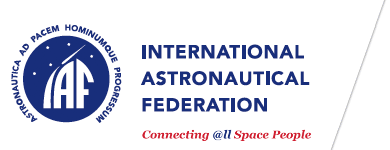Technical programme
IAC-16 — 67th International Astronautical Congress
E5. 27th IAA SYMPOSIUM ON SPACE AND SOCIETY
This 27th symposium, organised by the International Academy of Astronautics (IAA), will review the impact and benefits of space activities on the quality of life on Earth including arts and culture, society's expectations from space and life in space, as well as technology and knowledge transfer.
- Coordinator
Geoffrey Languedoc
Canadian Aeronautics & Space Institute (CASI) — CanadaOlga Bannova
University of Houston — United States
E5.1. Architecture for humans in space: design, engineering, concepts and mission planning
The session welcomes papers on all aspects of the challenges of emplacing, sustaining, and growing accommodations for space habitation throughout the inner solar system: Earth orbits, Lagrange points, the Moon's surface, interplanetary space, Near Earth Objects, the moons of Mars, the surface of Mars and the asteroid Main Belt. These places share a need for basic protection against space radiation, vacuum and thermal extremes, but vary widely in remoteness, proximity to gravity wells and resources, and socio-psychological impact. Architectural solutions, including pressurized volume, shielding, life support, food production, transportation access and social accommodation will stretch concepts and technologies for space architecture. The session seeks papers on topics including but not limited to: integration of architecture, structures, space systems, life-support systems, man-machine interfaces and new technologies.
- Co-Chair
Olga Bannova
University of Houston — United StatesBrent Sherwood
— United States
- Rapporteur
Anna Barbara Imhof
Liquifer Systems Group (LSG) — Austria
E5.2. Models for Successfully Applying Space Technology Beyond Its Original Intent
Many R&D organizations look for ways to demonstrate the value of their technology portfolio to educate as well as to accommodate a broad community of onlookers and users. Academia- and government-sponsored space programs need to depict how their science and technology activities are relevant to knowledge sharing, technology commercialization and technology transfer. Papers will explore a variety of approaches that organizations can adopt for the successful transfer of technologies that impact new products and services for space and non-space applications. Relevant legislation, business structures, models, metrics, and alternative technology transfer models will be discussed. Papers will provide examples of successful models with descriptions of the approach and tools used, results to date, issues addressed, and ongoing changes made.
- Co-Chair
Olga Bannova
University of Houston — United StatesNona Cheeks
Retired NASA — United States
- Rapporteur
Anna Barbara Imhof
Liquifer Systems Group (LSG) — Austria
E5.3. Contemporary Arts Practice and Outer Space: A Multi-Disciplinary Approach
Since the late 1970s a number of artists have been negotiating access to space facilities and organisations, critiquing or making experiential the exploration and utilisation of space, or re-purposing space technology, materials or data independently or in direct exchange with the space sector. Today this practice is branching into a several directions, ranging from performance, installation, video, or conceptual work situated in the space or space analogous environments themselves, to commercial gallery contexts and the realm of participation and public engagement with science. This session addresses the practice of contemporary artists who have developed new ways to appropriate space for their work, the conceptual and practical foundations of their engagement, and the implications of this emerging aesthetic paradigm for both the fields of space and art. Submissions are welcome from artists and art historians, and from space industry and space agency representatives as well as from the cultural sector facilitating or programming related projects crossing over the increasingly blurred boundaries of creative practice.
- Chairman
Richard Clar
Art Technologies — United States
- Co-Chair
Nahum Romero Zamora
KOSMICA — Germany
- Rapporteur
Daniela De Paulis
SETI Institute — United States
E5.4. Space Assets and Disaster Management
This session will explore the role space assets can play in situations requiring disaster management and emergency response. Papers will discuss how space assets and applications can be brought to bear to assist with situation monitoring and assessment, shortening response times and mitigating impact on affected populations.
- Co-Chair
Geoffrey Languedoc
Canadian Aeronautics & Space Institute (CASI) — CanadaJillianne Pierce
Space Florida — United States
- Rapporteur
Alexander Gibson
Army National Guard — United States
E5.5. Space Societies, Professional Associations and Museums
Space societies, professional associations and museums form a special and important group of IAF members - nearly one quarter of the membership and, as a sector, second in size after space industries. They include professional societies, space museums, space associations, non-profit organisations and other organisations interested in space activities. Some have a large membership of 10 000 or more, others can be small; a few are already a century old, others are just being created. They exist in traditional and emerging space nations. Together they champion the interests of an impressive number of individuals and organizations connected to space. This symposium offers a podium for ideas and proposals to enhance the interaction between the organisations, their members and the Federation. Papers may address proposals to exchange experiences and best practices; sharing articles, exhibitions or educational material; novel ideas to help outreach to the general public, etc. Of particular interest are papers exploring ways to foster communication and collaboration and to develop mutual benefits amongst young societies, representatives of emerging space nations and museums within and outside the IAF family.
- Co-Chair
Scott Hatton
The British Interplanetary Society — United KingdomJean-Baptiste Desbois
SEMECCEL Cité de l'Espace — France
- Rapporteur
Minoo Rathnasabapathy
Massachusetts Institute of Technology (MIT) — United States
E5.IP. Interactive Presentations
Authors with an abstract accepted for an interactive presentation will be asked to prepare slides and display them for the duration of the congress on plasma screens. Authors will be assigned to interactive sessions in which they must be near the plasma screens to engage in interactive discussions with other congress attendees.
- Coordinator
Geoffrey Languedoc
Canadian Aeronautics & Space Institute (CASI) — CanadaOlga Bannova
University of Houston — United States
